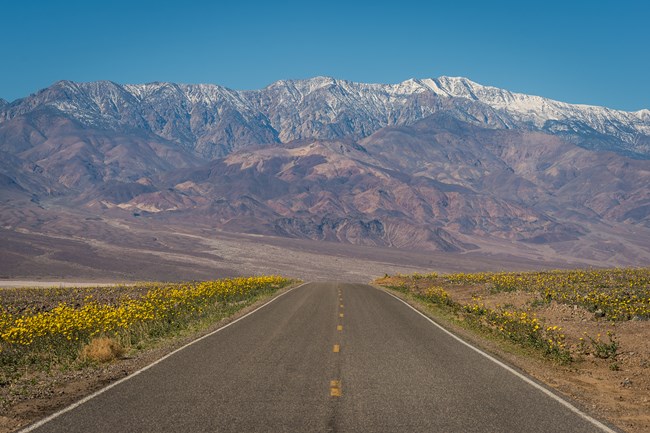
NPS Photo
Death Valley National Park was originally established as a national monument in 1933 and subsequently re-designated as a national park in 1994. It is not only the largest park unit within the Mojave Desert Network, but the largest national park unit in the contiguous United States. It is home to the nation's highest recorded temperature (134 ºF) and the lowest elevation (282 feet below sea level). Because of its dramatic topographic relief, the park supports a large diversity of plants and animals, and also has one of the nation's most significant fossil records.
From Scotty's Castle to a historic mining past, to fragile species found nowhere else in the world, to sand dunes and unique geologic formations, Death Valley has a number of cultural and natural resources that warrant protecting.
The Mojave Desert Network provides natural resource inventory and monitoring information to help parks make effective, science-based management decisions. Inventories have been completed for mammals, fish, birds, vascular plants, and reptiles & amphibians (see species lists further down the page). Maps and Reports detailing Death Valley's vegetation, soils, and geology resources are also complete.
Monitoring at Death Valley National Park
Ongoing Monitoring Efforts
Bats monitoring bat populations using acoustic and capture surveys
Desert Springs monitoring water quality and availability at over 200 smaller water sources such as seeps and springs
Invasive & Exotic Plants monitoring plan for detecting invasive plants throughout the Park
Selected Large Springs monitoring water quality and availability at five larger persistent springs
Spring Vegetation monitoring desert spring plant communities at select springs
Weather and Climate monitoring temperature, precipitation, wind and other variables at park service and partner weather stations
Coming Soon (additional monitoring currently in development)
Integrated Uplands vegetation and soils monitoring of the Blackbrush community
Reports & Publications
Inventories & Assessments present baseline data collected during the first phase of the development of the Mojave Desert Inventory & Monitoring Network in order to have comparison with the long-term monitoring data currently being collected. Monitoring protocols describe why and how we collect, manage, analyze, and report monitoring data about the network's Vital Signs. The protocols consist of a narrative and associated set of standard operating procedures (SOPs). Monitoring Reports summarize data and findings from our Vital Signs monitoring activities.
Source: NPS DataStore Collection 4376 (results presented are a subset). To search for additional information, visit the NPS DataStore.
Source: NPS DataStore Collection 4378 (results presented are a subset). To search for additional information, visit the NPS DataStore.
Source: NPS DataStore Collection 4380 (results presented are a subset). To search for additional information, visit the NPS DataStore.
Source: NPS DataStore Collection 4379 (results presented are a subset). To search for additional information, visit the NPS DataStore.
Select a Park:
Select a Species Category (optional):
Visit NPSpecies for more comprehensive information and advanced search capability. Have a suggestion or comment on this list? Let us know.
Last updated: December 7, 2023
